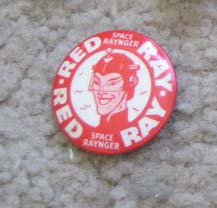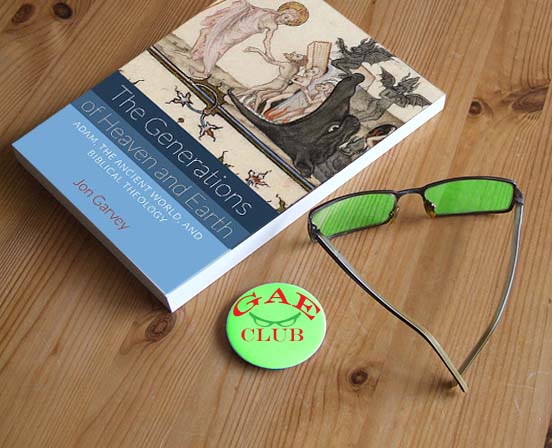
When I was about five, I joined the TV comic’s Red Ray Club, whose badge was proudly preserved in the family until my brother wisely threw it out of his home a year or two ago.

I don’t remember my membership number, though I do recall that of the more mature Eagle Club I joined a couple of years later: EB1152/9, if you want to steal my identity.
Red Ray, though, was a cartoon superhero with some kind of X-ray vision mediated by (you guessed it) red rays. But the real idea was that if you joined the club, you got a pair of red cellophane-and-card specs. Each week the strip included a frame of tangled and unreadable lines and figures, but when viewed through your member’s magic glasses, you could read a number of birth dates. If you found your own birthday, you got a prize (which I never did).
It worked because the red filters made the red and yellow ink merge into the page, leaving the blue and green print visible. And in that respect, it’s a fair illustration of every research paradigm, such as Neodarwinian evolutionary theory, climate alarmism… and Genealogical Adam and Eve.
You first have to “get” the paradigm. But once you do, every phenomenon makes sense in its terms, and those phenomena that don’t comply simply disappear, like TV Comic’s red and yellow noise. In a sense that what such paradigms are for – they reduce the pervasive noise in the world so you can make sense of it better. And that’s OK unless what is written in red or yellow ink happens to be your birthday.
So, once you “get” Darwinian evolution, “nothing makes sense” except in its light. It has explanatory power regardless of whether it is ultimately true or not.
Once you “get” anthropogenic climate change, everything bad that happens in the world (wildfires, volcanically melting Antarctic glaciers, walruses falling off cliffs or getting eaten by bears) is explained by it, whereas nothing good is. Only yesterday, our local TV station noted the greatly increased numbers of dolphins appearing off Cornwall in recent years. “It must be the better water quality,” said the local naturalist. But warmer water is more likely the cause, except that this might suggest that climate change brings benefits as well as disaster, which is outside the paradigm.
In fact, although evidence may be a major reason for your accepting a paradigm, even that initial evidence passes through the filter of what we might call your “plausibility structure,” which is about what you are prepared to believe. Thereafter the paradigm becomes a belief for you, and is applied as such to whatever further phenomena you encounter.
You are then more likely to explain, say, gaps in the fossil record by some “epicycle” of evolutionary theory than to reject an evolutionary explanation; or to explain the coldest temperature in Edmonton, Alberta, this century (as my cousin informed me) in terms of global warming, rather than as counter-evidence.
The subjectivity of paradigms is just a fact of life, rather than being good or bad – but it’s better to acknowledge it, since it should remind us to keep checking our paradigms, and not just the evidence. The latter will always have been censored by the former.
I suspect that a good many people who read my new book The Generations of Heaven and Earth will be quite comfortable with the Genealogical Adam paradigm because they’ll either have read about it here over a period of time or in Joshua Swamidass’s The Genealogical Adam and Eve. They will have come not only to see its truth, but to think in its terms. I’m all for that, of course, because it is a paradigm well-supported by science and agreeable to Scripture. And I have a book to sell!
What may be more of a challenge for many readers is the scheme of biblical theology to which I apply GAE in the book. The idea of this is that the prophetic biblical authors were from the beginning, to some degree, aware of God’s intentions in “salvation history,” including the expectation that history would culminate in a hoped for Messiah. They wrote about this hope knowingly, including many mysterious characteristics that only came to fruition in Jesus.
The problem for us is that we have had over two centuries of critical scholarship that has cast doubt not only on the biblical authors’ ability to record history, still less have insight into future events, but on the very possibility of such things. And yet Jesus and the New Testament writers took it for granted:
“If you believed Moses, you would believe me, for he wrote about me.” (John 5:46)
Concerning this salvation, the prophets, who spoke of the grace that was to come to you, searched intently and with the greatest care, trying to find out the time and circumstances to which the Spirit of Christ in them was pointing when he predicted the sufferings of the Messiah and the glories that would follow. It was revealed to them that they were not serving themselves but you, when they spoke of the things that have now been told you by those who have preached the gospel to you by the Holy Spirit sent from heaven. (1 Pet 1:10-12).
I first got to grips with embracing this paradigm through John Sailhamer’s monumental Meaning of the Pentateuch, in which he documents how the Torah is not, primarily, about God’s giving the law to Israel to establish them as his people, but about giving them his law as a response to their faithlessness, and the consequent need for national (and world) salvation through Messiah.
A lot of my gradual acceptance of it came from understanding better, through Sailhamer’s wisdom, the literary methods of the prophetic authors. That was compounded by similar observations and examples by other authors such as Seth Postell and Greg Beale. And that, basically, is how this kind of biblical theology got into my book. Like any other paradigm, readers unfamiliar with it may have to work a little until they get their X-ray spectacles adjusted.
I mention all this because of my present reading, another book in the same vein that actually came out whilst my own offering was at the publisher. It’s Kevin Chen’s The Messianic Vision of the Pentateuch (IVP Academic, 2019), and I may decide to review it when I’ve finished it, because it’s excellent.
Cheng carries on where Sailhamer left off, looking in more detail at specific references to the Messiah in the Pentateuch. What I notice is that reading Sailhamer back in 2014, particularly his treatment of Israel’s first encounter with Yahweh at Sinai, I kept thinking, “This makes so much sense, but is it maybe stretching the meaning of the text too much?” But with Cheng I find that far more detailed and nuanced passages and intertextual connections are now blatantly obvious, and really make no sense “except in the light of the paradigm.” I’ve adjusted to the spectacles I’m using.
It’s not simply (though it may be partly!) that because I’ve embraced the paradigm, I interpret everything by it. Rather it’s that there are things in the text that I simply didn’t see before, because my previous red spectacles filtered them out.
That, I think, is the test of a good paradigm: as the mediaeval philosophers noted, it “saves the appearances,” that it, it doesn’t reject so many of the phenomena as noise. Yet even a good paradigm is, in the end, a belief. Even in academic studies, it seems, faith is primary.


GAE club pin? That’s pretty cool. Where did you get that???
Amazing what you can do with Photoshop, Josh.
I had to fake everything – the pin, the green spec lenses – and even my book, of which I’ve not received any copies yet since the wagon train from Oregon is so slow. So the cover graphic had to be skewed and put onto another book.
Mr Deep Fake, me! Maybe the real club should have a fig-leaf on the logo?